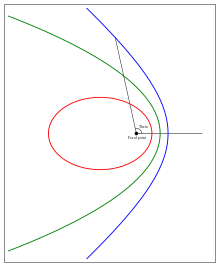
Back Keplerwentelbaan Afrikaans مدار كيبلر Arabic Keplerovská dráha Czech Keplerbahn German Órbita de Kepler Spanish مدار کپلری Persian Mouvement képlérien French Orbit Kepler ID 케플러 궤도 Korean Keplerbunn LB

In celestial mechanics, a Kepler orbit (or Keplerian orbit, named after the German astronomer Johannes Kepler) is the motion of one body relative to another, as an ellipse, parabola, or hyperbola, which forms a two-dimensional orbital plane in three-dimensional space. A Kepler orbit can also form a straight line. It considers only the point-like gravitational attraction of two bodies, neglecting perturbations due to gravitational interactions with other objects, atmospheric drag, solar radiation pressure, a non-spherical central body, and so on. It is thus said to be a solution of a special case of the two-body problem, known as the Kepler problem. As a theory in classical mechanics, it also does not take into account the effects of general relativity. Keplerian orbits can be parametrized into six orbital elements in various ways.
In most applications, there is a large central body, the center of mass of which is assumed to be the center of mass of the entire system. By decomposition, the orbits of two objects of similar mass can be described as Kepler orbits around their common center of mass, their barycenter.
© MMXXIII Rich X Search. We shall prevail. All rights reserved. Rich X Search